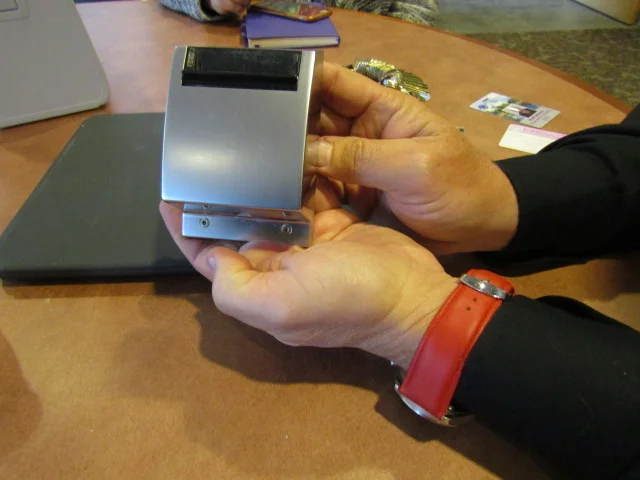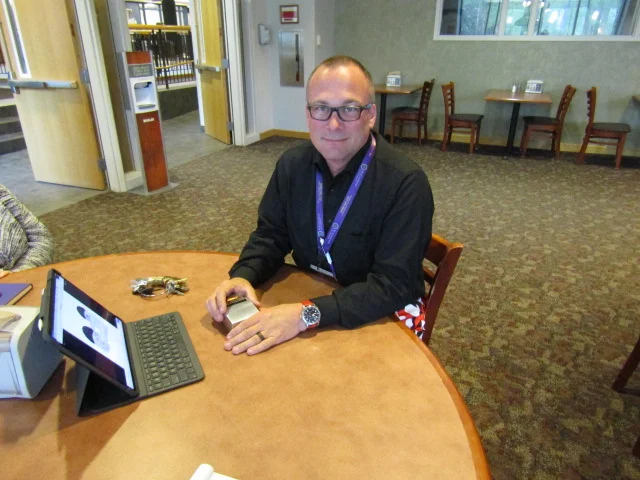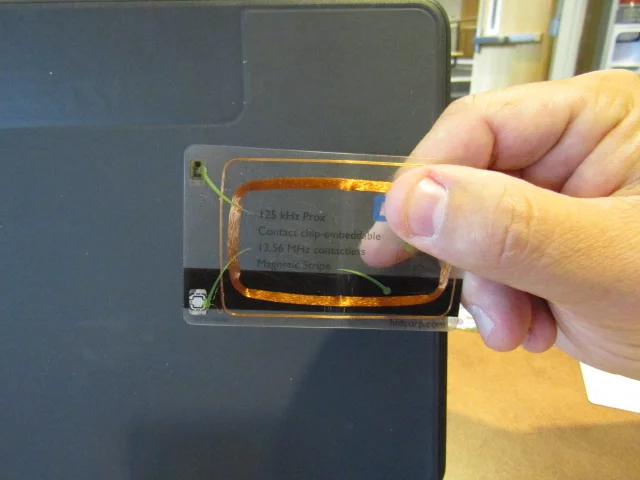New Student IDs are More than Touch and Go
Pictured above: The old swipe-card system
For many, the first task to begin the semester was picking up a new student ID. Much like former campus IDs, these can be used for dining services, at the library, and to access certain spaces on campus. Among other big changes at St. Kate’s, it may have been easy to overlook the little black touchpads where these IDs can be scanned. Although they may seem like a small change at first, the new IDs are just one aspect of a larger plan for long-term campus security.
“I like it better than the keys overall,” said Bailey Bahnsen (Interpreting ‘22). Along with working at the CATIE Center, Bahnsen is a desk worker in Caecelian Hall and a Resident Advisor (RA) on St. Mary’s second floor. St. Mary’s was the first residence hall to fully adopt the new card access system, with students arriving on campus to find it already installed. As an RA and a desk worker, Bahnsen is quite familiar with issues related to keys and security on campus. I asked for her take on the student impact of the new card access system. Generally, it was a practical change for her floor.
“You don’t have to carry an extra key which I like,” said Bahnsen, demonstrating how easily the key fits on her lanyard. She also cited the way that the ID’s can enhance safety. With the new locking system, doors lock automatically behind a resident when they leave. “This never happened to me, but I heard that people used to steal stuff from people’s unlocked rooms during fire drills,”she said.
There are, however, a few downsides for residents when their doors lock automatically. “It’s a lot easier to lock yourself out,” said Bahnsen, who even admits to locking herself out of her room much more than in previous years. She also shared that the system can be a little difficult to operate at times. “You have to put it at just the right angle every time.”
Mark Johnson, VP of Facilities
I went behind the scenes to interview Mark Johnson, Vice President of Facilities, to find out what is really going on inside these new cards.
It turns out that when you’re repeatedly tapping your card on the touchpad in the cafeteria or frantically trying to enter your residence hall, your ID is thinking hard. It’s communicating with the touch pad and a larger authorization network managed by Public Safety. “Just tapping it, people get frustrated,” said Johnson. “We now have a two-tiered authentication system.”
Inside the new ID’s
This is new. Just like the two-step authentication required by many applications, the new IDs actually have two antennas built in. (See picture.) When you hold your card to the touchpad, a message is sent by the inner antenna, telling the reader who you are. The outer antenna then establishes whether or not you’re allowed to access a given space or perform whatever action you’re trying to perform. All of this can be managed easily by the university. “We’ve encrypted our cards at the same time too,” said Johnson. For example, if you lose your ID, it is programmed so that Public Safety can easily disable it and activate a new one. This is a much needed departure from the old system.
The previous card access system was operating using 25-year-old technology. In order to update card-access privileges, staff had to separately re-program about 190 different card readers all around campus. This led to delays in building access and massive security issues. Additionally, key loss was very costly. Instead of paying to change the entire lock on a door with a lost key, students can make a quick stop to Public Safety to have their lost card deactivated.
Finally, ditching the old swipe system has improved the longevity of the cards. “We’re going to a contactless chip system,” said Johnson. The old system had a magnetic strip that had to be slid into a reader. This led to extensive wear on the cards, and frequent demagnetization from exposure to technology. Public Safety frequently had to replace and re-encode old cards, which operated on such dated technology that they had only two remaining computers that were able to perform the task.
“We ended up printing nearly 8,000 new IDs,” said Johnson. This was a massive undertaking, but ultimately these IDs are able to tell us more. The color at the bottom of the photo side of the ID can also serve as an identifier. Purple is for students, grey is for faculty and staff, and red is for contractors not permanently employed by the university. The back side of the ID includes the same information as the old IDs, along with a barcode for the library.
Looking forward, Johnson shared that “we’ve future-proofed ourselves.” First of all, the cards are re-programmable and non-proprietary, meaning that they can be re-programmed for another company without replacing the entire system if necessary. “We can also put your entire key card on your phone,” said Johnson. ID cards would still be available, but this is just one of many options for the future. “We see ourselves being complete with the card system around 11/8 to 11/15,” said Johnson. Work is beginning in the residence halls and then moving to the academic buildings.
The current keys across St. Kate’s campus are anything but uniform. Because the university was built one building at a time, there was great variation in the types of keys and key companies used. “So, in some buildings,” said Johnson, “we have 5 or 6 different types of keys.” As for back-up keys and keys for areas that will not be accessed via the contactless chip, St. Kate’s is moving to a side-cut key system that cannot be duplicated and that can be cut right on campus for a much lower cost.
The implementation of the new card access system is an example of how St. Kate’s reconciles with its history and the needs of its student population in the face of changing technology and expectations. It can be easy to overlook the importance of these changes and the consideration that has gone into them. “We didn’t want to take someone’s pre-packaged ideas and force them on St. Kate’s,” said Johnson. Throughout the process of integration and big campus changes, the St. Kate’s community will need to find a balance between respected norms and potentially beneficial transformations.








